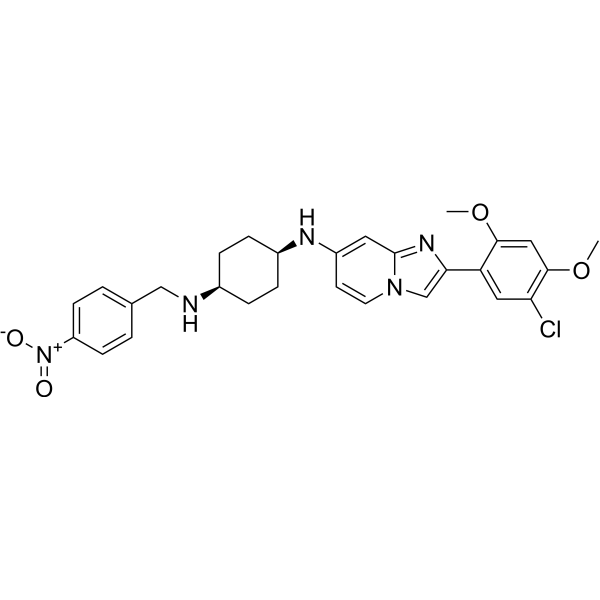Physicochemical Properties
| Molecular Formula | C28H30CLN5O4 |
| Molecular Weight | 536.021905422211 |
| Exact Mass | 535.198 |
| CAS # | 2093401-33-1 |
| PubChem CID | 134817271 |
| Appearance | Light yellow to yellow solid powder |
| LogP | 6.2 |
| Hydrogen Bond Donor Count | 2 |
| Hydrogen Bond Acceptor Count | 7 |
| Rotatable Bond Count | 8 |
| Heavy Atom Count | 38 |
| Complexity | 758 |
| Defined Atom Stereocenter Count | 0 |
| SMILES | ClC1C(=CC(=C(C=1)C1=CN2C=CC(=CC2=N1)NC1CCC(CC1)NCC1C=CC(=CC=1)[N+](=O)[O-])OC)OC |
| InChi Key | LGYQCBXDHOTMJD-UHFFFAOYSA-N |
| InChi Code | InChI=1S/C28H30ClN5O4/c1-37-26-15-27(38-2)24(29)14-23(26)25-17-33-12-11-21(13-28(33)32-25)31-20-7-5-19(6-8-20)30-16-18-3-9-22(10-4-18)34(35)36/h3-4,9-15,17,19-20,30-31H,5-8,16H2,1-2H3 |
| Chemical Name | 4-N-[2-(5-chloro-2,4-dimethoxyphenyl)imidazo[1,2-a]pyridin-7-yl]-1-N-[(4-nitrophenyl)methyl]cyclohexane-1,4-diamine |
| HS Tariff Code | 2934.99.9001 |
| Storage |
Powder-20°C 3 years 4°C 2 years In solvent -80°C 6 months -20°C 1 month |
| Shipping Condition | Room temperature (This product is stable at ambient temperature for a few days during ordinary shipping and time spent in Customs) |
Biological Activity
| Targets | SUV39H2/KMT1B |
| ln Vitro | OTS193320 (0.125-0.5 μM; 24 hours) prevents breast cancer cell lines from proliferating. SUV39H2-positive A549 lung cancer cells have growth inhibited by OTS193320 (IC50=0.38 μM)[1]. OTS193320 (0.5 μM; 48 hours) causes breast cancer cells to undergo apoptosis [1]. In a dose-dependent manner, OTS193320 (0.125-0.5 μM; 24 hours) lowers H3K9me3 levels [1]. OTS193320 attenuates γ-H2AX, which makes breast cancer cells more susceptible to doxorubicin. When compared to single agent therapy with either agent, the combination of OTS193320 and doxorubicin dramatically decreased cancer cell viability in vitro [1]. |
| Cell Assay |
Cell Viability Assay[1] Cell Types: MCF-7, SK-BR-3, ZR-75-1, T-47D, MDA-MB-231, BT-20 breast cancer cell lines Tested Concentrations: 0-1 μM Incubation Duration: 72 hrs (hours) Experimental Results: Had Growth inhibitory effect on MCF-7, SK-BR-3, ZR-75-1, T-47D, MDA-MB-231, and BT-20 breast cancer cell lines with IC50 values from 0.41 to 0.56 μM, respectively. Apoptosis Analysis[1] Cell Types: MDA-MB-231 and BT-20 cells Tested Concentrations: 0.5 μM Incubation Duration: 48 hrs (hours) Experimental Results: demonstrated an increase in the number of cells at early- and late-stage apoptosis. Western Blot Analysis[1] Cell Types: MDA-MB-231 and BT-20 cells Tested Concentrations: 0.125, 0.25, 0.5 μM Incubation Duration: 24 hrs (hours) Experimental Results: Caused attenuation of H3K9me3 levels in a dose-dependent manner. |
| References |
[1]. Development of novel SUV39H2 inhibitors that exhibit growth suppressive effects in mouse xenograft models and regulate the phosphorylation of H2AX. Oncotarget. 2018 Aug 7;9(61):31820-31831. |
Solubility Data
| Solubility (In Vitro) | DMSO : 62.5 mg/mL (116.60 mM) |
| Solubility (In Vivo) |
Solubility in Formulation 1: ≥ 6.25 mg/mL (11.66 mM) (saturation unknown) in 10% DMSO + 40% PEG300 + 5% Tween80 + 45% Saline (add these co-solvents sequentially from left to right, and one by one), clear solution. For example, if 1 mL of working solution is to be prepared, you can add 100 μL of 62.5 mg/mL clear DMSO stock solution to 400 μL PEG300 and mix evenly; then add 50 μL Tween-80 to the above solution and mix evenly; then add 450 μL normal saline to adjust the volume to 1 mL. Preparation of saline: Dissolve 0.9 g of sodium chloride in 100 mL ddH₂ O to obtain a clear solution. Solubility in Formulation 2: ≥ 6.25 mg/mL (11.66 mM) (saturation unknown) in 10% DMSO + 90% Corn Oil (add these co-solvents sequentially from left to right, and one by one), clear solution. For example, if 1 mL of working solution is to be prepared, you can add 100 μL of 62.5 mg/mL clear DMSO stock solution to 900 μL corn oil and mix evenly. (Please use freshly prepared in vivo formulations for optimal results.) |
| Preparing Stock Solutions | 1 mg | 5 mg | 10 mg | |
| 1 mM | 1.8656 mL | 9.3280 mL | 18.6560 mL | |
| 5 mM | 0.3731 mL | 1.8656 mL | 3.7312 mL | |
| 10 mM | 0.1866 mL | 0.9328 mL | 1.8656 mL |
